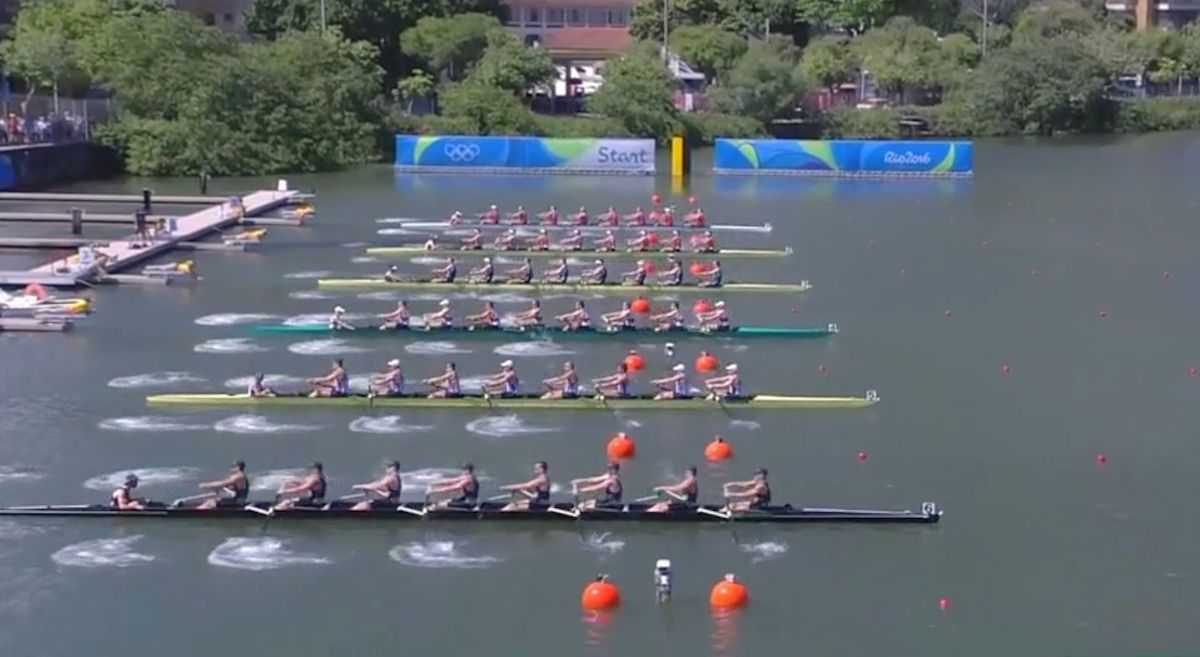There are two different ways to row a boat with a bunch of oars. You can either do it synchronously, with everyone pulling all together and at the same time, or asynchronously, with rowers pulling in some sort of sequence, like a repeating wave. Nobody who knows what they’re doing with a boat (and this includes all of the Olympic rowing teams) ever does the asynchronous thing, and the assumption is that a rowing team that all pulls together is stronger and more efficient than a rowing team that pulls out of sync.
But here’s the thing: If you look at the hydrodynamics of a boat, a direct result of large speed variations is increased friction on the hull, and that means wasted energy compared to a boat propelled more steadily. With that in mind, French researchers decided to find out if rowing asynchronously might in fact be more efficient, and they have to put it to the test with a little racing boat filled with… wait for it… row bots.
In a recent article in Physics Today, Jean-Philippe Boucher, Romain Labbé, and Christophe Clanet from the Laboratory of Hydrodynamics (LadHyX) at the École Polytechnique in Paris explain that, when rowers are in sync, each stroke generates a lot of thrust all at once and the boat accelerates. Then the boat cruises along, decelerating by about 20 percent, while the rowers all reset their oars for another stroke, and then the cycle repeats. The researchers estimate that these large speed fluctuations result in about 5 percent more friction along the boat’s hull than you’d get if the boat was moving at a constant speed instead. That 5 percent doesn’t sound like a lot, but could it be the difference between a gold and silver medal at the Olympics?
Rather than try and work out all the physics and make some sort of numbery, hand-wavy abstract assertion, the researchers built a 1/10 scale racing boat with eight little Arduino-controlled robotic rowers. The 2-meter long fiberglass model has the same shape as a real boat, and the mass ratio of robot rowers to the boat’s hull is the same as what you’d find in a human-crewed racing boat. What’s more, the robots themselves move forwards and backwards with each stroke as they reposition their bodies and oars, just like a human crew does.

Initial results with the row bots showed that they provided a reasonably accurate model for a full-scale human-crewed boat, rowing at one stroke per second and reaching a top speed of 0.2 boat length per rowing cycle (0.36 m/s). This is much slower than Olympic speed (0.45 boat length per cycle or better), but still usable for their experiments. The researchers then began varying the phase of the row bots, and with each individual row bot rowing at 45 degrees out of phase of the row bots next to it, the boat was able to drastically reduce how much its speed varied, down from 12 percent with synchronous rowing to just 2 percent.
At this point, everyone who has been part of a rowing team can breathe a sigh of relief, because even though the speed variations were reduced when the row bots were rowing asynchronously (thus reducing losses to fluid friction), the overall speed of the boat was reduced as well, and this proved to be the case for all asynchronous tests at any phase. Rowing together, in sync, really is the fastest and most efficient way of rowing.
Here’s what the researchers say is going on:
In our initial thinking, we failed to take into account that the rowers are not stationary. Indeed, the speed in the synchronized configuration keeps increasing at the beginning of the recovery stroke—that is, after the oars have been lifted from the water. If the velocity keeps increasing when the oars are out of the water, there must be an additional propulsive force that does not depend on oars. In fact, the force results from the motion of the rowers on the boat. When the rowers return together to the stern of the boat during the recovery stroke, they pull the hull beneath them and accelerate the boat. Since the crew of a coxed eight weighs several times what the boat does, the rowers generate a significant force. When they are desynchronized, that inertial boost is reduced.
Good, glad that all makes sense then. And we can also all be glad (or perhaps slightly disappointed?) that eight little row bots didn’t suddenly upset centuries of human rowers.
Evan Ackerman is a senior editor at IEEE Spectrum. Since 2007, he has written over 6,000 articles on robotics and technology. He has a degree in Martian geology and is excellent at playing bagpipes.



